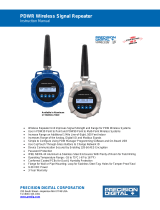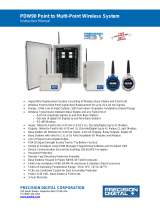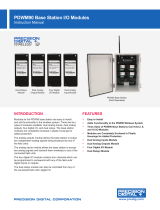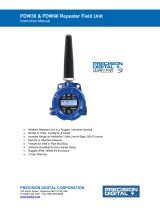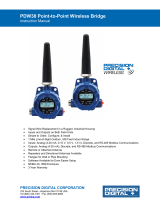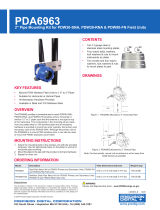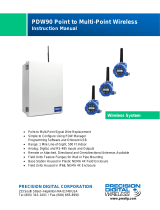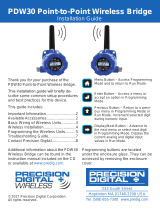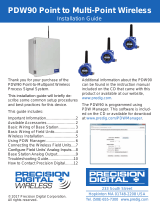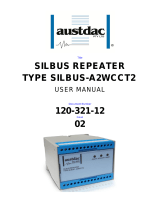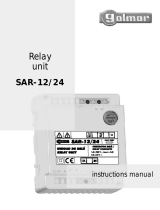Page is loading ...

PDW30 Point-to-Point Wireless Bridge
Instruction Manual
PRECISION DIGITAL CORPORATION
233 South Street • Hopkinton MA 01748 USA
Tel (800) 343-1001
www.predig.com
• Signal Wire Replacement Bridge Consisting of a Matched Pair of Wireless Field Units
• Virtually Plug and Play Right out of Box
• Range: 1 Mile Line-of-Sight Outdoor, 500 Feet Indoor; Repeaters Available to Extend Range
• Wireless Transmission Between Primary and Secondary Unit of
o 4-20 mA (Separate Signals Going Both Ways)
o Discrete (4 digital I/O Signals Going Both Ways)
o RS-485 Modbus
• Inputs: (Wired to Units) 4-20 mA or 0-10 V (1), Discrete/Digital (up to 4), Modbus
• Outputs: (Wired to Units) 4-20 mA (1), Discrete/Digital (up to 4), Relays (2, optional), Modbus
• Loss of Signal (LoS) Digital Output
• PDA10 Signal Strength Survey Tool to "Try Before You Buy"
• Field Installable Relay Module with Two Form A (SPST) 5A Relays (Available for Both Units)
• Simple to Configure Using PDW Manager Programming Software and On-Board USB
• Backlit Display Provides Helpful Input & Output Information
• CapTouch Through-Glass Button Programming for Non-Advanced Settings
• Device Communication Secured by Enabling 128-bit AES Encryption
• Password Protection
• Remote Yagi Directional Antennas Available
• IP68, NEMA 4X Aluminum & Stainless Steel Enclosures With Plenty of Room for Field Wiring
• Operating Temperature Range: -55 to 75°C (-67 to 167°F)
• Conformal Coated PCBs for Dust & Humidity Protection
• Flange for Wall or Pipe Mounting; Loop for Stainless Steel Tag; Holes for Tamper-Proof Seal
• 9-30 VDC Power
• 3-Year Warranty
Available in
Stainless Steel

PDW30 Point-to-Point Wireless Bridge
Instruction Manual
2
Table of Contents
Introduction ......................................................................................................... 4
Key Features ....................................................................................................... 5
PDW Manager PC Software ........................................................................... 5
Relays Option Module .................................................................................... 6
CapTouch Through-Glass Buttons ............................................................... 6
PDW30 Units Available in Aluminum or Stainless Steel ............................. 6
Wireless Solutions in Complex Areas .......................................................... 6
Application Examples ........................................................................................ 7
Wireless Tank Level Monitoring.................................................................... 7
Wireless Tank Level Monitoring of Level Switches..................................... 8
Wireless Remote Valve Control .................................................................... 9
Wireless Transmission of Modbus Inputs and Outputs ........................... 10
Extending Signal Range with PDWR Repeaters ........................................ 11
Ordering Information ........................................................................................ 12
Accessories .................................................................................................. 12
Specifications ................................................................................................... 14
General .......................................................................................................... 14
Enclosure ...................................................................................................... 14
Analog Input ................................................................................................. 14
Isolated 4-20 mA Transmitter Output ......................................................... 15
Digital Inputs / Outputs ................................................................................ 15
Loss of Signal (RF) ....................................................................................... 15
Optional Relays ............................................................................................ 15
Wireless Radio ............................................................................................. 16
RS-485 Modbus® RTU Serial Communications .......................................... 16
PDW Manager Software ............................................................................... 16
PDWR Wireless Repeater ............................................................................ 17
Safety Information ............................................................................................ 18
Unpacking ......................................................................................................... 18
Installation......................................................................................................... 18
Mounting Instructions .................................................................................. 18
Cover Jam Screw ......................................................................................... 18
Dimensions ....................................................................................................... 19
Connections ...................................................................................................... 20
Installing Display & Relays Option Modules .............................................. 20
Connectors Labeling .................................................................................... 21
Wiring Diagrams ........................................................................................... 22
Power Connections .................................................................................... 22
Power PDW30 and 2-Wire Transmitter from Same Power Supply ............ 22
Input Signal Connections ........................................................................... 22
4-20 mA Output Connections ..................................................................... 22
Digital I/O Connections .............................................................................. 23
Loss of RF Signal Connections .................................................................. 23
Relays Option Connections........................................................................ 23
Modbus RTU Serial Communications ........................................................ 23
Setup and Programming .................................................................................. 24
Overview ....................................................................................................... 24
Buttons & Displays ...................................................................................... 24
Programming Buttons ................................................................................. 24
CapTouch Buttons ....................................................................................... 25
CapTouch Button Tips ............................................................................... 25
Quick Tip ....................................................................................................... 25
PDW Manager Software ............................................................................... 26

PDW30 Point-to-Point Wireless Bridge
Instruction Manual
3
Display Functions & Messages ................................................................... 27
Primary Unit ............................................................................................... 27
Secondary Unit .......................................................................................... 28
Setup Menu ................................................................................................... 28
Entering Numeric Values ........................................................................... 29
Primary Device Menus ............................................................................... 29
Network and Modbus Setup ....................................................................... 29
Secondary Device Menus .......................................................................... 30
Display Signal I/O and Digital I/O Status .................................................... 30
Programming with PDW Manager ............................................................... 31
Analog Input & Output Calibration .............................................................. 32
Troubleshooting ............................................................................................... 34
Factory Defaults & User Settings................................................................ 38
Table of Figures
Figure 1. Enclosure & Antenna Dimensions – Front View ............................ 19
Figure 2. Enclosure Dimensions – Side View ................................................ 19
Figure 3. Enclosure Dimensions – Top View ................................................. 19
Figure 4. PDWA6963-SS Stainless Steel Pipe Mounting Kit ............................. 19
Figure 5. PDW30 Display Module Connectors ............................................... 21
Figure 6. PDWM-2RY Relays Option Module Connectors ............................. 21
Figure 7. Power Connections .......................................................................... 22
Figure 8. PDW30 and 2-Wire Transmitter Powered from Same Supply ....... 22
Figure 9. Analog Input Connections ............................................................... 22
Figure 10. 4-20 mA Output Connections ........................................................ 22
Figure 11. Digital I/O Connections .................................................................. 23
Figure 12. Loss of Signal Connections .......................................................... 23
Figure 13. Relays Controlled by Digital Outputs ........................................... 23
Figure 14. Five-Wire RS-485 Modbus Connections ....................................... 23
Figure 15. Three-Wire RS-485 Modbus Connections .................................... 23
Figure 16. Multiple Device RS-485 Modbus Connections ............................. 23

PDW30 Point-to-Point Wireless Bridge
Instruction Manual
4
Disclaimer
The information contained in this document is
subject to change without notice. Precision Digital
Corporation makes no representations or
warranties with respect to the contents hereof;
and specifically disclaims any implied warranties
of merchantability or fitness for a particular
purpose.
• Read complete instructions prior to installation
and operation of the meter.
• Risk of electric shock or personal injury.
• This product is not recommended for life support
applications or applications where
malfunctioning could result in personal injury or
property loss. Anyone using this product for
such applications does so at their own risk.
Precision Digital Corporation shall not be held
liable for damages resulting from such improper
use.
• The term “discrete” is sometimes used in this
document to refer to digital inputs and outputs,
where the value is either 0 or 1 (Logic Low or
High).
• When referencing Modbus, this manual uses the
terms “Client” to refer to what was previously
called “Master” and “Server” to refer to what was
previously called “Slave”.
WARNING
Cancer and Reproductive Harm - www.P65Warnings.ca.gov
Limited Warranty
Precision Digital Corporation warrants this
product against defects in material or
workmanship for the specified period under
“Specifications” from the date of shipment from
the factory. Precision Digital’s liability under this
limited warranty shall not exceed the purchase
value, repair, or replacement of the defective unit.
See Warranty Information and Terms &
Conditions on www.predig.com for complete
details.
Registered Trademarks
Modbus® is a registered trademark of Schneider
Electric. All other trademarks mentioned in this
document are the property of their respective
owners.
© 2023 Precision Digital Corporation.
All rights reserved.
Introduction
The Precision Digital PDW30 provides a simple,
straightforward way to get an analog, discrete (digital)
or Modbus signal from where you have it to where
you need it – without having to run wires! It’s a point-
to-point wireless bridge that is virtually plug and play
right out of the box.
The PDW30 consists of a primary and a secondary
unit and communication between the two is by-direc-
tional. That means you can send 4-20 mA, discrete
and Modbus signals from the primary unit to the sec-
ondary unit and also send completely different 4-20
mA, discrete and Modbus signals from the secondary
unit to the primary unit. For instance, the primary unit
could send a 4-20 mA signal to the secondary unit
corresponding to the level in a tank and the second-
ary unit could send a 4-20 mA signal to the primary
unit to control a valve.
Primary and secondary units are also equipped with
four digital I/O that can each be independently pro-
grammed as an input or an output. A Loss of Signal
warning is also available by connecting devices to the
G and LS screw terminals.
To indicate alarm situations, both units can be
equipped with an optional, field installable, two relay
module. These relays are rated Form A (SPST) 5A.
The specified range between the primary and second-
ary unit is 1 mile line-of-sight outdoor and 500 feet in-
door and repeaters are available to extend the range.
A low-cost wireless survey tool, Model PDA10, is
available to test the signal strength of your application
before you buy. And if the PDW30 system does not
work in your application, you can return it for full
credit!
The PDW30 is available in either aluminum or stain-
less steel NEMA 4X, IP68 enclosures and these en-
closures contain plenty of room for field wiring con-
nections.
Most applications require minimal programming and
can be operational in minutes. However, free pro-
gramming software is available and if touch ups are
needed after installation, the instrument can be pro-
grammed without re-moving the cover using
CapTouch buttons.
A wide range of accessories, including mounting kits,
antenna-related accessories, and repeaters are avail-
able. The antenna comes attached to the unit and can
also be remotely located. High gain directional anten-
nas are also offered.

PDW30 Point-to-Point Wireless Bridge
Instruction Manual
5
Key Features
PDW Manager PC Software
PDW Manager PC Software allows for programming
the PDW30 wireless primary units and secondary
units from a PC with a USB connection. The units
connect to a PC via the USB connection on the side
of the display module behind the cover of the
enclosure. Use of PDW Manager is required for
programming advanced settings such as wireless
encryption and analog signal calibration. PDW
Manager is available for download at
www.predig.com/pdwmanager.
Easy-To-Install Display Module
The display module designed specifically for the
PDW30 wireless units is easy to remove making it
convenient for wiring the unit. The display module is
completely enclosed for added protection when wiring
and handling.

PDW30 Point-to-Point Wireless Bridge
Instruction Manual
6
Relays Option Module
The PDW30 primary and secondary units are availa-
ble with a relays option module that includes two
Form A (SPST) relays. The module is easily installed
by the user into the base of the enclosure with the
four screws provided. The removable connector plugs
make wiring easy.
CapTouch Through-Glass
Buttons
The PDW30 primary and secondary units are
equipped with four capacitive sensors that operate as
through-glass buttons so that they can be operated
without removing the cover (and exposing the elec-
tronics) in an unclean area.
CapTouch buttons are designed to work under any
lighting condition and are not affected by random
changes in light or shadows. To protect against false
triggering a long button press of about 2 seconds is
required to wake up the buttons when they have not
been in use.
PDW30 Units Available in
Aluminum or Stainless Steel
The PDW30 primary and secondary units are availa-
ble in an IP68, NEMA 4X aluminum or stainless steel
enclosure. The enclosures feature a built-in flange for
wall or pipe mounting, built-in loop for a stainless steel
tag, locking screw, and hole for a tamper-proof wire &
seal. The enclosure also includes two 3/4" threaded
conduit openings for wiring. The PDW30 units can
operate in temperatures of -55 to 75°C (-67 to 167°F).
Wireless Solutions in Complex
Areas
The PDW30 has a range of 500 ft. indoors and an
outside line-of-sight range of 1 mile. Any wireless net-
work can be negatively affected by certain factors,
such as physical obstacles and improper equipment
placement. Precision Digital sells several solutions for
tricky wireless installations, such as remote antennas
and repeater field units. Our PDA10 wireless survey
kit allows for testing of the wireless signal strength
prior to installation so that you know your wireless
units will connect the first time.

PDW30 Point-to-Point Wireless Bridge
Instruction Manual
7
Application Examples
Wireless Tank Level Monitoring
Note: Power requirements / connections not shown in diagram. Consult manuals for details.
• The 4-20 mA level transmitter is connected to the analog input of the secondary unit.
• The mA signal is transmitted to the primary unit.
• The primary unit's analog output is connected to a PD6602 loop-powered meter, which displays the 4-20 mA
signal as volume in gallons.
• The PD6602 is programmed to indicate an alarm condition when the level exceeds 7000 gallons as displayed
on the meter.
• Relay 1 on the meter connects to digital input 1 of the primary unit.
• The low and high alarm light / horn in the field are driven as follows:
o Relay 1 (RY-1) in the PD6602 display is connected to digital input 1 (DI-1) on the primary unit. This
signal is wirelessly transmitted to the secondary unit. (On the secondary unit) digital output 1 (DO-
1) controls relay 1 (RY-1), which turns on the high alarm light / horn, warning the operator.
o Relay 2 (RY-2) in the PD6602 display is connected to digital input 2 (DI-2) on the primary unit. This
signal is wirelessly transmitted to the secondary unit. (On the secondary unit) digital output 2 (DO-
2) controls relay 2 (RY-2), which turns on the low alarm light / horn, warning the operator.
Parts Needed for This System:
PDW30
Model Number
Qty
Description
PDW30-GP-AL-PAIR
1
PDW30 Point-to-Point Wireless Bridge (Primary and Secondary Units), Aluminum Enclosure
PDWM-2RY
1
Relays Option Module, Two Form A (SPST)
Other Products
Model Number
Qty
Description
PDA-LHR
2
Red Light / Horn
PD6602-L2N
1
1/8 DIN Loop-Powered Digital Panel Meter with Two Relays

PDW30 Point-to-Point Wireless Bridge
Instruction Manual
8
Wireless Tank Level Monitoring of Level Switches
Note: Power requirements / connections not shown in diagram. Consult manuals for details.
• The switch contacts from the two level switches in each tank are connected to the digital inputs on the
secondary unit.
• The states of the switch contacts are wirelessly transmitted to the primary unit.
• The digital outputs from the primary unit are connected to a PD154 Vigilante II 4-point annunciator.
Parts Needed for This System:
PDW30
Model Number
Qty
Description
PDW30-GP-AL-PAIR
1
PDW30 Point-to-Point Wireless Bridge (Primary and Secondary Units), Aluminum
Enclosure
Other Products
Model Number
Qty
Description
PD154-6R2-1
1
1/8 DIN 4-Input Alarm Annunciator

PDW30 Point-to-Point Wireless Bridge
Instruction Manual
9
Wireless Remote Valve Control
Note: Power requirements / connections not shown in diagram. Consult manuals for details.
• The level transmitter’s 4-20 mA signal is connected to the primary unit's analog input.
• The PDW30 primary unit then wirelessly transmits the level signal to the secondary unit located in the control
room, where the secondary unit’s 4-20 mA output duplicates the signal.
• The secondary unit’s 4-20 mA output is connected to a PD6602 that displays the level and operates a high and
low alarm. In this example, the meter is indicating a low alarm.
• The operator uses a PD460 valve positioner to send a mA signal to the secondary unit's analog input.
• That valve position signal is wirelessly transmitted to the primary unit located in the field at the tank, where the
primary unit's 4-20 mA output duplicates the signal.
• The primary unit’s 4-20 mA output is connected to a digital valve positioner. The valve is opened, and the tank
starts to fill again.
• The operator monitors the level rising on the PD6602 and uses the PD460 valve positioner to close the valve
when the tank reaches the desired level.
Parts Needed for This System:
PDW30
Model Number
Qty
Description
PDW30-GP-AL-PAIR
1
PDW30 Point-to-Point Wireless Bridge (Primary and Secondary Units), Aluminum Enclosure
Other Products
Model Number
Qty
Description
PDA-LHR
2
Red Light / Horn
PD6602-L2N
1
1/8 DIN Loop-Powered Digital Panel Meter with Two Relays
PD460
1
Panel Mount 4-20 mA Valve Positioner

PDW30 Point-to-Point Wireless Bridge
Instruction Manual
10
Wireless Transmission of Modbus Inputs and Outputs
Note: Power requirements / connections not shown in diagram. Consult manuals for details.
• Tank level is measured by Modbus enabled level transmitters.
• The ConsoliDator+ Modbus client is connected to the primary unit and sends requests to the level transmitters.
• The ConsoliDator+ processes the data and displays it in engineering units.
• The PD6730X Modbus scanners provide tank side indication of level, temperature, interface and other Modbus
variables.
• Modbus client must be connected to the primary RS-485.
Parts Needed for This System:
PDW30
Model Number
Qty
Description
PDW30-GP-AL-PAIR
1
PDW30 Point-to-Point Wireless Bridge (Primary and Secondary Units), Aluminum Enclosure
Other Products
Model Number
Qty
Description
PDA-LHR
4
Red Light / Horn
PD6730-AX0-I-2
3
General Purpose Modbus Scanner for Tank Side Level Indication

PDW30 Point-to-Point Wireless Bridge
Instruction Manual
11
Extending Signal Range with PDWR Repeaters
Note: Power requirements / connections not shown in diagram. Consult manuals for details.
• The 4-20 mA level transmitter is connected to the analog input of the secondary unit.
• The mA signal is transmitted to the repeater unit and then retransmitted to the primary unit.
• The primary unit's analog output is connected to a PD6602 loop-powered meter, which displays the 4-20 mA
signal as volume in gallons.
• The PD6602 is programmed to indicate an alarm condition when the level exceeds 7000 gallons as displayed
on the meter.
• Relay 1 on the meter connects to digital input 1 of the primary unit and transmits the signal to the secondary unit
via the repeater unit.
• The low and high alarm light / horns in the field are driven as follows:
o Relay 1 (RY-1) in the PD6602 display is connected to digital input 1 (DI-1) on the primary unit. This signal
is wirelessly transmitted to the secondary unit via the PDWR repeater. (On the secondary unit) digital
output 1 (DO-1) controls relay 1 (RY-1), which turns on the high alarm light / horn, warning the operator.
o Relay 2 (RY-2) in the PD6602 display is connected to digital input 2 (DI-2) on the primary unit. This signal
is wirelessly transmitted to the secondary unit via the PDWR repeater. (On the secondary unit) digital
output 2 (DO-2) controls relay 2 (RY-2), which turns on the low alarm light / horn, warning the operator.
Parts Needed for This System:
PDW30
Model Number
Qty
Description
PDW30-GP-AL-PAIR
1
PDW30 Point-to-Point Wireless Bridge (Primary and Secondary Units), Aluminum Enclosure
PDWR-GP-AL-REP
1
PDWR Repeater to Extend Wireless Distance, Aluminum Enclosure
PDWM-2RY
1
Relays Option Module, Two Form A (SPST)
Other Products
Model Number
Qty
Description
PDA-LHR
2
Red Light / Horn
PD6602-L2N
1
1/8 DIN Loop-Powered Digital Panel Meter with Two Relays

PDW30 Point-to-Point Wireless Bridge
Instruction Manual
12
Ordering Information
Model
Description
PDW30-GP-AL-PAIR
PDW30 Point-to-Point Wireless
Bridge (Primary and Secondary
Units), Aluminum Enclosure1
PDWR-GP-AL-REP
PDWR Repeater to Extend
Wireless Distance, Aluminum
Enclosure1
PDW30-GP-SS-PAIR
PDW30 Point-to-Point Wireless
Bridge (Primary and Secondary
Units), Stainless Steel Enclosure1
PDWR-GP-SS-REP
PDWR Repeater to Extend
Wireless Distance, Stainless
Steel Enclosure1
PDWM-2RY
Relays Option Module,
Two Form A (SPST) 2
Accessories
Model
Description
PDA10
PDW Wireless Signal
Strength Survey Tool
PDWA3120-N
20-Foot RP-SMA F to N Male
Extension Cable for Yagi
Antenna3
PDWA3140-N
40-Foot RP-SMA F to N Male
Extension Cable for Yagi
Antenna3
PDWA3120-S
20-Foot RP-SMA M/F
Extension Cable for
Omnidirectional Antenna3
PDWA3140-S
40-Foot RP-SMA M/F
Extension Cable for
Omnidirectional Antenna3
PDWA3900-6Y-N
Yagi Antenna 6dB
PDWA3900-9Y-N
Yagi Antenna 9dB
PDWA3900-20-N
PDW 900 MHz
Omnidirectional Antenna, M20
PDWA3900-34-N
PDW 900 MHz
Omnidirectional Antenna,
3/4" NPT
PDWA6963-SS
Stainless Steel Pipe Mount Kit
for One PDW30 Primary/
Secondary Unit, PDW90 Field
Unit or PDWR Repeater Unit
PDAPLUG75
3/4" Metal Conduit/Stopping
Plug
PDAREDUCER-75M-50F
M-3/4" NPT to F-1/2" NPT
Reducer with Approvals
PDAREDUCER-75M-M20F
M-3/4" NPT to F-M20
Reducer with Approvals
PDA-MICROUSB
Micro-USB PC Programming
Cable for Field Unit (supplied)
PDA-SSTAG
Custom Stainless Steel Tag
Notes:
1. The PDW30 wireless units come standard with two 3/4"
NPT conduit holes. To order models with M20 conduit
holes instead, add -22 at the end of the part number
(e.g. PDW-GP-AL-PAIR-22)
2. The PDWM-2RY Relays Option Module is installed by
the customer using the four screws provided.
3. Antenna extension cables include the following parts:
(1) Extension Cable, (1) Antenna Coupler, (1) 8" Length
of Coax Seal Tape, (1) 3/4" NPT Cable Gland
PDWR Wireless Signal Repeaters
PDWR wireless signal repeaters are used to
retransmit wireless signals when connectivity is an
issue. They are simple to install as they only require
power and a network ID. Any PDW units in range of
the repeater with the same network ID will retransmit
through it, thus increasing signal strength. Use
repeaters to broadcast over very long distances or
around permanent obstacles.
Model Number
Description
PDWR-GP-AL-REP
PDWR Repeater to Extend
Wireless Distance, Aluminum
Enclosure1
PDWR-GP-SS-REP
PDWR Repeater to Extend
Wireless Distance, Stainless
Steel Enclosure1
PDWA6963-SS Pipe Mounting Kit
The PDWA6963-SS provides a convenient way to
mount one PDW30 primary/secondary, PDWR
repeater, or PDW90 field unit to a horizontal or
vertical 1.5" or 2" pipe such that the antenna is not
right on top of the metal pipe.
Model Number
Description
PDWA6963-SS
Stainless Steel Pipe Mount Kit for
One PDW30 Primary/Secondary
Unit, PDW90 Field Unit or PDWR
Repeater Unit

PDW30 Point-to-Point Wireless Bridge
Instruction Manual
13
PDA10 Wireless Surveying Tool Kit
The handheld and target units are used to survey
wireless signal strength throughout nonhazardous ar-
eas of a facility prior to PDW30 or PDW90 equipment
installation. The target unit is set in a desired installa-
tion location and the handheld is brought to another
installation location. The handheld unit will provide an
indication of signal strength between the two units.
Model Number
Description
PDA10
PDW Wireless Signal Strength
Survey Tool Kit
PDWA3900 Yagi High-Gain Directional Antenna
The PDWA3900 Yagi Antennas are made to work
with point-to-point and point to multi-point applica-
tions. These high gain antennas are ideal to use with
Precision Digital's PDW products because they give
you the flexibility of installing the antenna exactly
where you need to bridge your point-to-point wireless
process signals while keeping the PDW unit in a con-
venient location for monitoring.
Model Number
Description
PDWA3900-6Y-N
Remote 6 dB Yagi High-Gain
Directional Antenna
PDWA3900-9Y-N
Remote 9 dB Yagi High-Gain
Directional Antenna
PDWA3100 Antenna Extension Cables
*Included with PDWA3120-N or PDWA3140-N Extension Cable.
The PDWA3120-N and PDWA3140-N are 20-foot and
40-foot extension cables used to extend the distance
between the Yagi Antenna and the PDW30 or PDW90
wireless units. The extension cables also come with
an antenna coupler to connect the PDW wireless
device to the antenna extension cable, coax seal
tape, and a 3/4" NPT cable gland.
Model Number
Description
PDWA3120-N
20-Foot RP-SMA F to N Male
Extension Cable for Yagi Antenna
PDWA3140-N
40-Foot RP-SMA F to N Male
Extension Cable for Yagi Antenna
*Included with PDWA3120-N or PDWA3140-N Extension Cable.
PDWA3120-N or
PDWA3140-N
Extension Cable*
N-Connector
Fitting*
Coax Seal Tape*
Yagi Antenna
Cable
Gland*
PDWA3120-N or
PDWA3140-N
Extension Cable*
N-Connector
Fitting*
Coax Seal Tape*
Yagi Antenna
Cable
Gland*

PDW30 Point-to-Point Wireless Bridge
Instruction Manual
14
Specifications
Except where noted all specifications apply to operation at +25°C.
General
System
PDW30 consists of a Primary and a
Secondary unit, each with built-in antennas.
Display
32-character dual-line alphanumeric dot
matrix LCD display with backlight
Visual Area: 2.54" x 0.63" (64.6 x 16.0 mm)
Character Height: 0.2" (5.5 mm)
Display used for programming assistance
and displaying communications link status,
signal strength, values for the analog in-
puts and outputs, and status of digital in-
puts and outputs.
Network ID
Field selectable: 0 - 99
Peak Antenna
Gain
1.8 dBi +/- 1.0
Programming
Methods
Programming (complete): PC with PDW
Manager software
Programming (all but advanced): Four
CapTouch through-glass buttons
Recalibration
All inputs and outputs are calibrated at the
factory. Recalibration is recommended at
least every 12 months.
Process/
Digital I/O
Display
Press the Next button once to display the
present analog input and output. Press the
Next button again to display digital I/O
states.
Password
A programmable password restricts
modification of program settings.
Input Power
9-30 VDC, 2.5 W max
Note: If analog and digital outputs are off:
1.0 W min
Non-Volatile
Memory
All programmed settings are stored in non-
volatile memory for a minimum of ten
years if power is lost.
Isolation
500 V
Environmental
Operating temp. range: -55 to 75°C
(display inoperable < -20 °C)
Storage temp. range: -55 to 85°C
Relative humidity:
0 to 90% non-condensing
Printed circuit boards are conformally
coated
Connections
Removable screw terminal blocks accept
12 to 26 AWG wire.
Connectors
Tightening
Torque
4.5 lb-in (0.5 Nm)
Mounting
May be mounted directly to conduit.
Built-in flange for 1.5" to 2" pipe or wall
mounting. See Dimensions on page 19 for
mounting space requirements.
Overall
Dimensions
5.25" x 11.63" x 4.80"
(133 mm x 295 mm x 122 mm)
(W x H x D)
Weight
Aluminum: 5.6 lbs (2.5 kg)
Stainless Steel: 9.8 lbs (4.4 kg)
Warranty
3 years parts and labor. See Warranty
Information and Terms & Conditions on
www.predig.com for complete details.
Enclosure
Material
-AL Models:
ASTM A413 LM6 die-cast aluminum,
copper-free, enamel coated.
-SS Models:
ASTM A743 CF8M investment-cast
316 stainless steel
Gasket
Fluoroelastomer
Rating
NEMA 4X, IP68
Color
-AL: Blue; -SS: Silver
Window
Borosilicate glass
Conduits
Three ¾" NPT threaded conduit openings;
One used for mounting the antenna (factory
installed), the other two available for field
wiring.
M20 conduits are available. See Ordering
Information on page 12 for details.
Flange
Built-in flange for wall and pipe mounting.
Tamper-
Proof Seal
Enclosure lid may be secured with
tamper-proof seal.
Instrument
Tag Loop
Built-in loop for securing stainless steel tag.
PDW30 Point-to-Point Wireless Bridge
Available in Stainless Steel
Analog Input
Field Selectable
Input
4-20 mA, 0-10 V, 0-5 V, 1-5 V
Accuracy
±0.03% of calibrated span ±1 count
Temperature Drift
0.005% of calibrated span/C max from
0 to 65C ambient, 0.01% of calibrated
span/C max from -40 to 0C ambient
Input
Impedance
Voltage ranges: greater than 110 k;
Current ranges: less than 220
HART
Transparency
HART signals will not transmit
wirelessly. The 4-20 mA signal value
will transmit normally (without any
HART information) even if a HART
signal is present.
The analog input will not interfere with
HART communications within the wired
4-20 mA loop.

PDW30 Point-to-Point Wireless Bridge
Instruction Manual
15
Isolated 4-20 mA Transmitter
Output
Output Source
Analog input from connected wireless
unit
Calibration
Factory calibrated:
4.000 to 20.000 = 4-20 mA output
Accuracy
± 0.1% of span ± 0.004 mA
Loop Power
Supply
Internally powered; no external supply
needed
Temperature Drift
0.4 µA/C max from 0 to 65C ambient,
0.8 µA/C max from -40 to 0C ambient
Loss of Signal
(RF)
After approximately 15 seconds of
trying to reconnect, the Loss of Signal
function will occur and result in the mA
output going to the Link Lost Output
value selected via the PDW Manager
software (i.e. 3.2, 3.5, 3.8, 20.5, 20.8,
23.0 mA, or Stay as Is).
External Output
Loop Resistance
Power supply
Minimum
24 VDC
10
Digital Inputs / Outputs
Channels
4 Four (discrete) digital I/O
connections, independently field
selectable as either inputs or outputs
DI Logic High
3 to 24 VDC (30 V tolerant)
DI Logic Low
0 to 1.1 VDC
DI Contact
Dry contact to ground can be used to
activate the input (Active Low)
DO Logic High
3.0 to 5.0 VDC
DO Logic Low
0 to 0.5 VDC
Output Source
Current
20 mA maximum output current
Input Sink
Current
0.5 mA minimum input current
I/O Operation Configured with PDW Manager
• Active Low Digital Input: A closed dry contact from
a digital input terminal to GND will result in a
digital output high on the corresponding output pin
of the other unit.
• Active High Digital Input: To reverse the output
logic, deselect the corresponding digital input box
in the PDW Manager software. An open circuit or
a logic high at the input will result in a digital
output high on the corresponding output pin of the
other unit.
Loss of Signal (RF)
Connections
Terminals G and LS on the Digital I/O
connector
Function
After approximately 15 seconds of
trying to reconnect, the Loss of Signal
function will occur and result in the Dig-
ital output going to the Link Lost Output
state selected via the PDW Manager
software.
Active: Logic high (5 V)
Inactive: Logic low (0 V)
Stay as Is: State does not change
Optional Relays
Number of Relays
(2) Two Form A (SPST)
Rating
250 VAC @ 5 A resistive load
30 VDC @ 5 A resistive load
250 VAC @ 2 A inductive load
30 VDC @ 2 A inductive load
Relay Isolation
(Dielectric Strength)
3,000 VAC, 50/60 Hz for 1 min
Noise
Suppression
Metal oxide varistors across contacts
Relay Control
Relay coils are controlled by the digital
outputs (e.g. DO-1 & DO-2)
• The relays option module is sold separately, and
it is installed on the base of the enclosure by the
user.

PDW30 Point-to-Point Wireless Bridge
Instruction Manual
16
Wireless Radio
Frequency
900 MHz
Range
500 ft (152.4 m) indoor,
1 mi (1.61 km) outdoor (line-of-sight)
Encryption
AES 128-bit encryption available using
PDW Manager software.
Interference
Reduction
Frequency Hopping Spread Spectrum
(FHSS)
Power Output
24 dBm (250 mW)
Sensitivity
-101 dBm
RS-485 Modbus® RTU Serial
Communications
• The Modbus Client must be connected to the
primary wireless unit.
Compatibility
EIA-485
Connectors
Removable screw terminal connector
Max Distance
3,937' (1,200 m) max
Baud Rate
1200 – 57,600 bps
Data
8 bit (1 start bit, 2 stop bits)
Parity
Even, Odd, or None with 1 or 2 stop bits
Modbus Timeout
0.5, 1, 2, 3, 4, 5 seconds;
user selectable
Isolation
1500 VRMS
PDW Manager Software
System
Requirements
Microsoft® Windows® 10/11
Communications
USB 2.0; Micro-USB Type B
Configuration
Configure devices one at a time.
Inputs on the primary unit are automati-
cally configured as outputs on the cor-
responding secondary unit.
Compatibility
The PDW Manager v2.00 is compatible
with firmware version 1.10; there is a
possibility of issues in the GUI (Graph-
ical User Interface), but it should not be
a problem configuring the supported
features.
Availability
Download from predig.com/pdwmanager

PDW30 Point-to-Point Wireless Bridge
Instruction Manual
17
PDWR Wireless Repeater
General
Display
32-character dual-line alphanumeric dot
matrix LCD display with backlight
Visual Area: 2.54" x 0.63" (64.6 x 16.0 mm)
Character Height: 0.2" (5.5 mm)
Display used for programming assistance
and displaying communications link status
and signal strength.
Number of
Repeaters
Up to 3 repeaters per system
Network ID
Field selectable: 0 - 99
Peak Antenna
Gain
1.8 dBi +/- 1.0
Programming
Methods
Change network ID and factory defaults only.
Four CapTouch through-glass buttons or PC
with PDW Manager software.
Password
A programmable password restricts
modification of programmed settings.
Input Power
9-30 VDC, 1.0 W max
Non-Volatile
Memory
All programmed settings are stored in non-
volatile memory for a minimum of ten
years if power is lost.
Isolation
500 V
Environmental
Operating temp. range: -55 to 75°C
(display inoperable < -20 °C)
Storage temp. range: -55 to 85°C
Relative humidity:
0 to 90% non-condensing
Printed circuit boards are conformally
coated
Connections
Removable screw terminal blocks accept
12 to 26 AWG wire.
Connectors
Tightening
Torque
4.5 lb-in (0.5 Nm)
Mounting
May be mounted directly to conduit.
Built-in flange for 1.5" to 2" pipe or wall
mounting. See Dimensions on page 19 for
mounting space requirements.
Overall
Dimensions
5.25" x 11.63" x 4.80"
(133 mm x 295 mm x 122 mm)
(W x H x D)
Weight
Aluminum: 5.6 lbs (2.5 kg)
Stainless Steel: 9.8 lbs (4.4 kg)
Warranty
3 year parts and labor. See Warranty
Information and Terms & Conditions on
www.predig.com for complete details.
Enclosure
Material
AL Models:
ASTM A413 LM6 die-cast aluminum,
copper-free, enamel coated.
-SS Models:
ASTM A743 CF8M investment-cast
316 stainless steel
Gasket
Fluoroelastomer
Rating
NEMA 4X, IP68
Color
-AL: Blue; -SS: Silver
Window
Borosilicate glass
Conduits
Three ¾" NPT threaded conduit openings;
One used for mounting the antenna (factory
installed), the other two available for field
wiring.
M20 conduits are available. See Ordering
Information on page 12 for details.
Flange
Built-in flange for wall and pipe mounting.
Tamper-Proof
Seal
Enclosure lid may be secured with
tamper-proof seal.
Instrument
Tag Loop
Built-in loop for securing stainless steel tag.
Wireless Radio
Frequency
900 MHz
Range
500 ft (152.4 m) indoor,
1 mi (1.61 km) outdoor (line-of-sight)
Encryption
AES 128-bit encryption available using
PDW Manager software
Interference
Reduction
Frequency Hopping Spread Spectrum
(FHSS)
Power Output
24 dBm (250 mW)
Sensitivity
-101 dBm
See the PDWR Wireless Repeater manual for more
information on how to extend the range of wireless
signals.

PDW30 Point-to-Point Wireless Bridge
Instruction Manual
18
Safety Information
• Read complete instructions prior to installation
and operation of the device.
• Read all product labels completely and follow all
instructions and requirements listed on the
labels for installation or service.
• Installation and service should be performed
only by trained service personnel. Service
requiring replacement of internal components
must be performed at the factory.
Unpacking
Remove both units from the boxes. Inspect the pack-
aging and contents for damage. Report damages, if
any, to the carrier. If any part is missing or the units
malfunction, please contact your supplier or the fac-
tory for assistance.
Installation
To access the connectors, remove the enclosure
cover and unclip the display module by pulling it from
the enclosure. The display module may be discon-
nected from the relays option module (if installed) to
facilitate field wiring.
Mounting Instructions
There are three ways to mount the PDW30:
1. To a wall with the built-in flange
2. To a 1.5" or 2" pipe using the PDWA6963-SS
stainless steel pipe mounting kit as shown in
Figure 4 on page 19.
3. Supported by the conduit using the conduit
holes provided.
The factory installed antenna is threaded into one of
the three conduit holes and may be moved as appro-
priate for the installation.
• Do not attempt to loosen or remove flange bolts
while the PDW30 is in service.
Cover Jam Screw
The cover jam screw should be properly installed
once the wireless units have been wired and tested.
The cover jam screw is intended to prevent the re-
moval of the units’ cover while in operation without the
use of tools. Using a M2 hex wrench, turn the screw
clockwise until the screw contacts the unit. Turn the
screw an additional 1/4 to 1/2 turn to secure the
cover.
• Excess torque may damage the threads and/or
wrench.
FCC Notice
Contains FCC ID: MCQ-XB900HP
The enclosed device complies with Part 15 of the
FCC Rules. Operation is subject to the following two
conditions: (i.) this device may not cause harmful in-
terference and (ii.) this device must accept any inter-
ference received, including interference that may
cause undesired operation.
• The RF module has been certified for remote and
base radio applications. If the module will be used
for portable applications, the device must
undergo SAR testing. This equipment has been
tested and found to comply with the limits for a
Class B digital device, pursuant to Part 15 of the
FCC Rules. These limits are designed to provide
reasonable protection against harmful
interference in a residential installation. This
equipment generates, uses, and can radiate radio
frequency energy and, if not installed and used in
accordance with the instructions, may cause
harmful interference to radio communications.
However, there is no guarantee that interference
will not occur in a particular installation.
• If this equipment does cause harmful interference
to radio or television reception, which can be
determined by turning the equipment off and on,
the user is encouraged to try to correct the
interference by one or more of the following
measures: Re-orient or relocate the receiving
antenna, Increase the separation between the
equipment and receiver. Connect equipment and
receiver to outlets on different circuits or consult
the dealer or an experienced radio/TV technician
for help.
Canada (IC) Notice
Contains Model: XB900HP, IC: 1846A-XB900HP
Integrator is responsible for its product to comply with
IC ICES-003 & FCC Part 15, Sub. B - Unintentional
Radiators. ICES-003 is the same as FCC Part 15
Sub. B and Industry Canada accepts FCC test
report or CISPR 22 test report for compliance with
ICES-003.

PDW30 Point-to-Point Wireless Bridge
Instruction Manual
19
Dimensions
Figure 1. Enclosure & Antenna Dimensions – Front View
Figure 2. Enclosure Dimensions – Side View
Figure 3. Enclosure Dimensions – Top View
PDWA6963-SS Stainless Steel
Pipe Mounting Kit
Figure 4. PDWA6963-SS Stainless Steel Pipe Mounting Kit

PDW30 Point-to-Point Wireless Bridge
Instruction Manual
20
Connections
To access the connectors, remove the enclosure cover and unclip the display module by pulling it from the enclosure.
Signal and power connections are made to removable connectors on the back of the display module. Relay output
connections (if installed) are made to removable connectors on the relays option module mounted in the base of the
enclosure. The display module may be disconnected from the relays option module to facilitate field wiring. Grounding
connections are made to the two ground screws provided on the base of the enclosure, one internal and one external.
• Static electricity can damage sensitive components.
• Observe safe handling precautions for static-sensitive components.
• Use proper grounding procedures/codes
• Observe all safety regulations. Electrical wiring should be performed in accordance with all agency
requirements and applicable national, state, and local codes to prevent damage to the device and ensure
personnel safety.
Installing Display & Relays Option Modules
The display module snaps into built-in rails on the enclosure ensuring a secure and perfect fit every time. No tools
are needed to install or remove it. The relays option module is screwed into the base of the enclosure with the four
screws provided. Both modules are completely enclosed to protect their printed circuit boards.
Display Module (Left) and Relays Option Module (Right)
Display Module Connected to Antenna
(Connect the antenna to the display module
using the included antenna coupler)
Relays Option Module Mounted on the Bottom of Enclosure
(Install the module using the four screws provided)
Display Module Mounted on Built-In Rails
(Snap the module into place lining it up with the rail caps)
/
